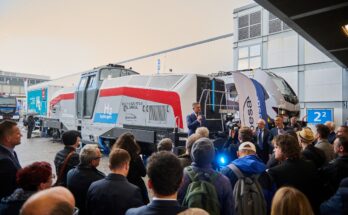Hydrogen will power the PESA SM42Dn locomotives in 2021. During the Impact CEE conference, the president of PESA presented the details of the SM42Dn hydrogen locomotive. The new model of the shunting locomotive will receive 170 kW (2 x 85 kW) Ballard hydrogen cells. The locomotive will have H35 compressed hydrogen tanks with a capacity of 175 kg. The total power of the locomotive’s electric motors will be 720 kW.
The shunting locomotive with hydrogen cells will be tested in Orlen in Płock in 2021. Orlen Koltrans will refuel the locomotive with H35 compressed hydrogen (350 bar) produced by the same capital group. The new hydrogen locomotive PESA SM42Dn will be able to haul trains weighing up to 3,200 tons. The drive will be powered by 4 asynchronous electric motors with a power of 720 kW (4 x 180 kW). The system will be supported by an LTO battery with a capacity of 167.7 kWh, from which the current will flow through ABB traction inverters with a 3 x 400 V auxiliary converter.
The hydrogen fuel in the PESA SM42Dn locomotive will be stored in tanks under a pressure of 350 bar. The tanks can hold 175 kg of H35 hydrogen at one time. The power source will be Ballard fuel cells manufactured in Canada. The PESA locomotive will be driven by a set of two cells with a total power of 170 kW (85 kW per one hydrogen cell). In addition to a modern power source, the PESA locomotive will have all the systems to become an autonomous rail vehicle. The prototype will be officially presented in September 2021 at the Trako 2021 trade fair in Gdańsk.
Hydrogen trains for passenger transport are also of interest to PESA. The fuel cells are to be delivered to the currently designed PESA Regio160 multiple units. One version of the passenger train reaching 160 km / h will have a hybrid hydrogen drive. Driving on a line with no traction it will be driven by a hydrogen cell, and on lines with electric traction – by electricity from the grid. The new PESA hydrogen-powered trains – locomotives and passenger trains – are to enable carriers to meet the EU Green Deal requirements. This means reducing CO2 emissions by 30% by the end of 2030 and achieving climate neutrality by 2050. To this end, the EU will support the transport sector with subsidies of up to EUR 480 billion by 2050.
Source: PESA


